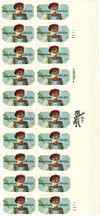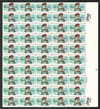
# 2024 - 1982 20c Ponce de Leon
U.S. #2024
1982 20¢ Ponce de Leon
- Honors first European explorer to visit Puerto Rico and Florida
- Pictures Ponce de Leon with a map of the areas he visited
Stamp Category: Commemorative
Value: 20¢, first-class rate
First Day of Issue: October 12, 1982
First Day City: San Juan, Puerto Rico
Quantity Issued: 110,261,000
Printed by: Bureau of Engraving and Printing
Printing Method: Photogravure
Format: Panes of 50 in sheets of 200
Perforations: 11
Why the stamp was issued: To honor the man credited with leading the first official European expeditions to Puerto Rico and Florida.
About the stamp design: Richard Schlecht created the art for this stamp. With no known portraits to work from, Schlecht chose to depict Pone de Leon as an older man, wearing an armored chest plate over a jacket with striped sleeves, and a feathered hat. Behind him appears a map with areas he explored including Florida and Puerto Rico.
First Day City: The First Day ceremony for this stamp was held at the San Juan Convention Center in San Juan, Puerto Rico on the opening day of the ESPAMER ’82 international philatelic exhibition.
Unusual fact about this stamp: Imperforate error stamps have been found.
History the stamp represents: On April 3, 1513, Juan Ponce de León landed on the Florida coast and claimed the area for Spain.
A decade earlier, Portuguese sailors are believed to have been the first Europeans to see and map the area that would become the southeastern United States. As early as 1511, rumors concerning undiscovered islands northwest of Hispaniola reached Spain, whose leaders were anxious to be the first to find them. Ponce de León was selected to have the honor, as a reward for his previous successes.
The contract granted León the rights to the discovery of Benimy and the nearby islands for three years. Additionally, he would be made governor for life of any lands he discovered. Though the contract didn’t mention it, many believe part of León’s mission was to search for the mythical Fountain of Youth.
The contract also stipulated that León conduct the expedition at his own expense. So he gathered three ships and 200 or more men and set out from Punta Aguada, Puerto Rico, on March 4, 1513. In late March they sighted an island (possibly in the Bahamas or the Florida mainland) but didn’t land. Then on April 2 they saw land again, believing it to be another island.
The next day, April 3, 1513, León led his ships toward the shore. As their ships drew nearer to the coast, the Spanish crew was treated to a burst of color. The deep blue waters they were navigating were framed by a wave of lush vegetation and brilliantly hued flowering plants.
It’s a matter of debate just where León came ashore. Possible sites include St. Augustine, Ponce de León Inlet, or Melbourne Beach. León stepped ashore, claimed the land for Spain, and named it La Florida, or “Feast of Flowers,” which is a reference to the Easter celebration in Spain. León is often considered to be the first documented European explorer in Florida. Though there is evidence that Spanish raiders may have gone there in secret, and some Native Americans knew some Spanish words, León was the first officially sanctioned to go there. The expedition spent a few hours exploring the area before returning to their ships. They then sailed south to map the coast.
In 1521, León returned to Florida to start a colony, but died from wounds he received in a battle with Native Americans.
U.S. #2024
1982 20¢ Ponce de Leon
- Honors first European explorer to visit Puerto Rico and Florida
- Pictures Ponce de Leon with a map of the areas he visited
Stamp Category: Commemorative
Value: 20¢, first-class rate
First Day of Issue: October 12, 1982
First Day City: San Juan, Puerto Rico
Quantity Issued: 110,261,000
Printed by: Bureau of Engraving and Printing
Printing Method: Photogravure
Format: Panes of 50 in sheets of 200
Perforations: 11
Why the stamp was issued: To honor the man credited with leading the first official European expeditions to Puerto Rico and Florida.
About the stamp design: Richard Schlecht created the art for this stamp. With no known portraits to work from, Schlecht chose to depict Pone de Leon as an older man, wearing an armored chest plate over a jacket with striped sleeves, and a feathered hat. Behind him appears a map with areas he explored including Florida and Puerto Rico.
First Day City: The First Day ceremony for this stamp was held at the San Juan Convention Center in San Juan, Puerto Rico on the opening day of the ESPAMER ’82 international philatelic exhibition.
Unusual fact about this stamp: Imperforate error stamps have been found.
History the stamp represents: On April 3, 1513, Juan Ponce de León landed on the Florida coast and claimed the area for Spain.
A decade earlier, Portuguese sailors are believed to have been the first Europeans to see and map the area that would become the southeastern United States. As early as 1511, rumors concerning undiscovered islands northwest of Hispaniola reached Spain, whose leaders were anxious to be the first to find them. Ponce de León was selected to have the honor, as a reward for his previous successes.
The contract granted León the rights to the discovery of Benimy and the nearby islands for three years. Additionally, he would be made governor for life of any lands he discovered. Though the contract didn’t mention it, many believe part of León’s mission was to search for the mythical Fountain of Youth.
The contract also stipulated that León conduct the expedition at his own expense. So he gathered three ships and 200 or more men and set out from Punta Aguada, Puerto Rico, on March 4, 1513. In late March they sighted an island (possibly in the Bahamas or the Florida mainland) but didn’t land. Then on April 2 they saw land again, believing it to be another island.
The next day, April 3, 1513, León led his ships toward the shore. As their ships drew nearer to the coast, the Spanish crew was treated to a burst of color. The deep blue waters they were navigating were framed by a wave of lush vegetation and brilliantly hued flowering plants.
It’s a matter of debate just where León came ashore. Possible sites include St. Augustine, Ponce de León Inlet, or Melbourne Beach. León stepped ashore, claimed the land for Spain, and named it La Florida, or “Feast of Flowers,” which is a reference to the Easter celebration in Spain. León is often considered to be the first documented European explorer in Florida. Though there is evidence that Spanish raiders may have gone there in secret, and some Native Americans knew some Spanish words, León was the first officially sanctioned to go there. The expedition spent a few hours exploring the area before returning to their ships. They then sailed south to map the coast.
In 1521, León returned to Florida to start a colony, but died from wounds he received in a battle with Native Americans.










